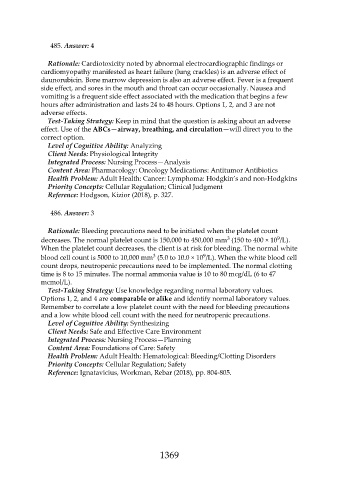Page 1369 - Saunders Comprehensive Review For NCLEX-RN
P. 1369
485. Answer: 4
Rationale: Cardiotoxicity noted by abnormal electrocardiographic findings or
cardiomyopathy manifested as heart failure (lung crackles) is an adverse effect of
daunorubicin. Bone marrow depression is also an adverse effect. Fever is a frequent
side effect, and sores in the mouth and throat can occur occasionally. Nausea and
vomiting is a frequent side effect associated with the medication that begins a few
hours after administration and lasts 24 to 48 hours. Options 1, 2, and 3 are not
adverse effects.
Test-Taking Strategy: Keep in mind that the question is asking about an adverse
effect. Use of the ABCs—airway, breathing, and circulation—will direct you to the
correct option.
Level of Cognitive Ability: Analyzing
Client Needs: Physiological Integrity
Integrated Process: Nursing Process—Analysis
Content Area: Pharmacology: Oncology Medications: Antitumor Antibiotics
Health Problem: Adult Health: Cancer: Lymphoma: Hodgkin’s and non-Hodgkins
Priority Concepts: Cellular Regulation; Clinical Judgment
Reference: Hodgson, Kizior (2018), p. 327.
486. Answer: 3
Rationale: Bleeding precautions need to be initiated when the platelet count
9
3
decreases. The normal platelet count is 150,000 to 450,000 mm (150 to 400 × 10 /L).
When the platelet count decreases, the client is at risk for bleeding. The normal white
9
3
blood cell count is 5000 to 10,000 mm (5.0 to 10.0 × 10 /L). When the white blood cell
count drops, neutropenic precautions need to be implemented. The normal clotting
time is 8 to 15 minutes. The normal ammonia value is 10 to 80 mcg/dL (6 to 47
mcmol/L).
Test-Taking Strategy: Use knowledge regarding normal laboratory values.
Options 1, 2, and 4 are comparable or alike and identify normal laboratory values.
Remember to correlate a low platelet count with the need for bleeding precautions
and a low white blood cell count with the need for neutropenic precautions.
Level of Cognitive Ability: Synthesizing
Client Needs: Safe and Effective Care Environment
Integrated Process: Nursing Process—Planning
Content Area: Foundations of Care: Safety
Health Problem: Adult Health: Hematological: Bleeding/Clotting Disorders
Priority Concepts: Cellular Regulation; Safety
Reference: Ignatavicius, Workman, Rebar (2018), pp. 804-805.
1369

